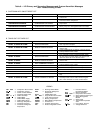
Water Treatment — Untreated or improperly treated wa-
ter may result in corrosion, scaling, erosion, or algae. The
services of a qualified water treatment specialist should be
obtained to develop and monitor a treatment program.
Water must be within design flowlimits, clean,and treated
to ensure proper chiller performance and reduce the
potential of tubing damage due to corrosion, scaling, ero-
sion, and algae. Carrier assumes no responsibility for
chiller damage resulting from untreated or improperly
treated water.
Inspect the Starting Equipment — Before work-
ing on any starter, shut off the chiller, and open all discon-
nects supplying power to the starter.
The disconnect on the starter front panel does not de-
energize all internal circuits. Open all internal and re-
mote disconnects before servicing the starter.
Never open isolating knife switches while equipment is
operating. Electrical arcing can cause serious injury.
Inspect starter contact surfaces for wear or pitting
on mechanical-type starters. Do not sandpaper or file silver-
plated contacts. Follow the starter manufacturer’s instruc-
tions for contact replacement, lubrication, spare parts order-
ing, and other maintenance requirements.
Periodically vacuum or blow off accumulated debris on
the internal parts with a high-velocity, low-pressure blower.
Power connections on newly installed starters may relax
and loosen after a month of operation. Turn power off and
retighten. Recheck annually thereafter.
Loose power connections can cause voltage spikes, over-
heating, malfunctioning, or failures.
Check Pressure Transducers — Once a year, the
pressure transducers should be checked against a pressure
gage reading. Check all three transducers: oil pressure, con-
denser pressure, cooler pressure.
Note the evaporator and condenser pressure readings
on the Status01 table on the LID. Attach an accurate set of
refrigeration gages to the cooler and condenser Schrader
fittings. Compare the two readings. If there is a difference in
readings, the transducer can be calibrated, as described in
the Troubleshooting Guide section.
Optional Pumpout System Maintenance —
For compressor maintenance details, refer to the 06D, 07D
Installation, Start-Up, and Service Instructions.
OPTIONAL PUMPOUT COMPRESSOR OIL CHARGE —
The pumpout compressor uses oil with the same specifi-
cations as the centrifugal compressor oil. For more details
on oil selection, see Oil Specification section, page 63.
The total oil charge, 4.5 pints (2.6 L), consists of
3.5 pints (2.0 L) for the compressor and one additional pint
(0.6 L) for the oil separator.
Oil should be visible in one of the compressor sight glasses
both during operation and at shutdown. Always check the
oil level before operating the compressor. Before adding or
changing oil, relieve the refrigerant pressure as follows:
1. Attach a pressure gage to the gage port of either com-
pressor service valve (Fig. 35).
2. Close the suction service valve and open the discharge
line to the storage tank or the chiller.
3. Operate the compressor until the crankcase pressure drops
to 2 psig (13 kPa).
4. Stop the compressor and isolate the system by closing
the discharge service valve.
5. Slowly remove the oil return line connection (Fig. 35).
Add oil as required.
6. Replace the connection and reopen the compressor serv-
ice valves.
OPTIONAL PUMPOUT SAFETY CONTROL SETTINGS
(Fig. 38) — The optional pumpout system high-pressure switch
should open at 220 ± 5 psig (1517 ± 34 kPa) and should
reset automatically on pressure drop to 190 psig (1310 kPa)
for HCFC-22 chillers. For chillers using HFC-134a, the
switch opens at 161 psig (1110 kPa) and closes at 130 psig
(896 kPa). Check the switch setting by operating the
pumpout compressor and slowly throttling the pumpout
condenser water.
Ordering Replacement Chiller Parts — When
ordering Carrier specified parts, the following information
must accompany an order:
• chiller model number and serial number
• name, quantity, and part number of the part required
• delivery address and method of shipment.
Fig. 38 — Optional Pumpout System
Controls
65


















